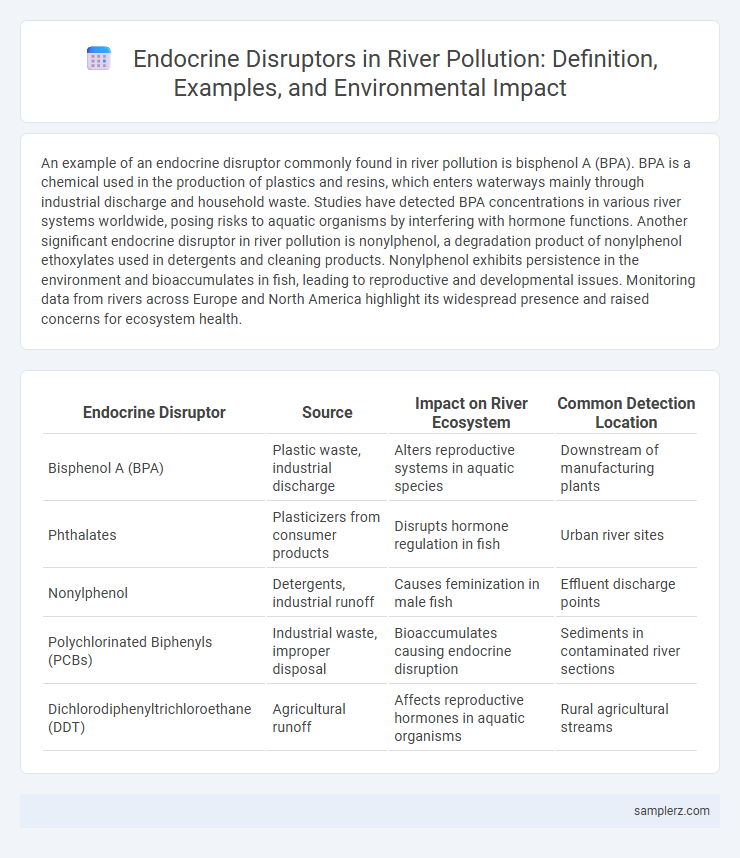An example of an endocrine disruptor commonly found in river pollution is bisphenol A (BPA). BPA is a chemical used in the production of plastics and resins, which enters waterways mainly through industrial discharge and household waste. Studies have detected BPA concentrations in various river systems worldwide, posing risks to aquatic organisms by interfering with hormone functions. Another significant endocrine disruptor in river pollution is nonylphenol, a degradation product of nonylphenol ethoxylates used in detergents and cleaning products. Nonylphenol exhibits persistence in the environment and bioaccumulates in fish, leading to reproductive and developmental issues. Monitoring data from rivers across Europe and North America highlight its widespread presence and raised concerns for ecosystem health.
Table of Comparison
| Endocrine Disruptor | Source | Impact on River Ecosystem | Common Detection Location |
|---|---|---|---|
| Bisphenol A (BPA) | Plastic waste, industrial discharge | Alters reproductive systems in aquatic species | Downstream of manufacturing plants |
| Phthalates | Plasticizers from consumer products | Disrupts hormone regulation in fish | Urban river sites |
| Nonylphenol | Detergents, industrial runoff | Causes feminization in male fish | Effluent discharge points |
| Polychlorinated Biphenyls (PCBs) | Industrial waste, improper disposal | Bioaccumulates causing endocrine disruption | Sediments in contaminated river sections |
| Dichlorodiphenyltrichloroethane (DDT) | Agricultural runoff | Affects reproductive hormones in aquatic organisms | Rural agricultural streams |
Common Endocrine Disruptors Found in River Systems
Common endocrine disruptors found in river systems include pharmaceuticals such as ethinylestradiol and bisphenol A, which interfere with aquatic organisms' hormone regulation. Pesticides like atrazine and chlorpyrifos contribute significantly to hormonal imbalance in fish populations. Industrial chemicals such as polychlorinated biphenyls (PCBs) and phthalates also persist in river sediments, disrupting reproductive and developmental processes.
Sources of Endocrine Disruptors Entering Rivers
Endocrine disruptors enter rivers primarily through industrial wastewater discharge, agricultural runoff containing pesticides and fertilizers, and untreated sewage effluents. Pharmaceuticals and personal care products, often improperly disposed of, also contribute significantly to river contamination. These sources introduce chemicals like bisphenol A, phthalates, and synthetic hormones, which interfere with aquatic organisms' hormonal systems.
Industrial Chemicals as River Endocrine Pollutants
Industrial chemicals such as polychlorinated biphenyls (PCBs) and bisphenol A (BPA) are prominent endocrine disruptors in river pollution, interfering with hormone function in aquatic organisms. These substances originate from manufacturing processes and waste discharge, accumulating in sediments and water bodies, leading to reproductive and developmental abnormalities in fish species. Monitoring and regulating industrial effluents containing these chemicals are critical to protecting river ecosystems and maintaining biodiversity.
Pharmaceuticals in River Water: A Hidden Threat
Pharmaceuticals such as synthetic estrogens from contraceptive pills and antibiotics frequently contaminate river water, acting as potent endocrine disruptors that interfere with the hormonal systems of aquatic organisms. These substances can cause reproductive abnormalities, developmental issues, and population declines in fish and amphibians, posing a significant ecological threat. Monitoring and reducing pharmaceutical residues in river water are critical steps toward protecting freshwater ecosystems from long-term hormonal disruption.
Agricultural Runoff: Pesticides and Endocrine Disruption
Agricultural runoff introduces pesticides such as atrazine and chlorpyrifos into river systems, acting as potent endocrine disruptors that interfere with the hormonal balance of aquatic organisms. These chemicals mimic or block natural hormones, leading to reproductive abnormalities, developmental issues, and population declines in fish and amphibians. Monitoring pesticide levels and implementing sustainable farming practices are critical steps to mitigate endocrine disruption in freshwater ecosystems.
Microplastics and Their Role as Endocrine Disruptors
Microplastics in river pollution act as significant endocrine disruptors by absorbing and transporting toxic chemicals like phthalates and bisphenol A (BPA), which interfere with hormone regulation in aquatic organisms. These pollutants mimic natural hormones, leading to reproductive and developmental problems in fish and amphibians. The accumulation of microplastics in river ecosystems amplifies endocrine-disrupting effects, posing threats to biodiversity and water quality.
Impact of Wastewater Effluents on River Endocrine Health
Wastewater effluents often contain endocrine disruptors such as bisphenol A and phthalates, which enter rivers and interfere with the hormonal systems of aquatic organisms. These chemicals alter reproductive functions, causing abnormalities like intersex fish and reduced fertility, thereby threatening biodiversity and ecosystem stability. Continuous monitoring of endocrine disruptors in river water is critical for developing effective pollution control and protecting freshwater health.
Persistent Organic Pollutants in River Ecosystems
Persistent Organic Pollutants (POPs) such as polychlorinated biphenyls (PCBs) and dioxins act as endocrine disruptors in river ecosystems, interfering with hormone function in aquatic organisms. These chemicals persist in the environment for decades, bioaccumulating through the food chain and causing reproductive and developmental abnormalities in fish and amphibians. Monitoring and mitigating POPs is critical to preserving biodiversity and maintaining the health of freshwater habitats.
Effects of Endocrine Disruptors on Aquatic Wildlife
Endocrine disruptors such as bisphenol A (BPA) and nonylphenol commonly found in river pollution interfere with hormone systems in aquatic wildlife, leading to reproductive abnormalities and altered development. Fish exposed to these chemicals often exhibit feminization of males and reduced fertility, which disrupts population dynamics and ecosystem balance. Chronic exposure to endocrine disruptors also impairs growth and immune responses, increasing vulnerability to disease and environmental stressors.
Strategies to Reduce Endocrine Disruptor Pollution in Rivers
Endocrine disruptors such as bisphenol A and phthalates commonly contaminate rivers through industrial discharge and agricultural runoff. Implementing advanced wastewater treatment technologies like activated carbon filtration and ozonation significantly reduces these chemical concentrations before water re-enters natural ecosystems. Promoting strict regulatory frameworks and incentivizing green chemistry alternatives also play crucial roles in minimizing endocrine-disrupting compounds in aquatic environments.

example of endocrine disruptor in river pollution Infographic
 samplerz.com
samplerz.com